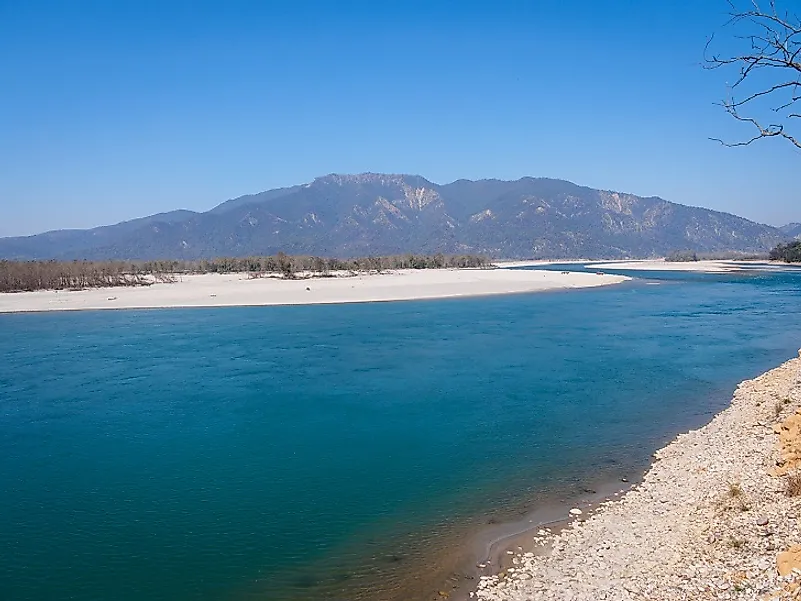Major Rivers Of Nepal (original) (raw)

A pristine stretch of the Ghaghara in Nepal's Terai Plains region.
Nepal is a country in Southern Asia that is found bordering China and India. It is a landlocked country and has a population of 26.4 million people. The country is a former monarchical government, but now it is a federal democratic republic. Nepal has a total area of 147.181 square kilometers. The landlocked country experiences different climatic conditions, such as extreme winter and breezy summer in the north and calm winter and subtropical summer in the south. Nepal experiences landslides, thunderstorms, and severe flooding. It also has several mighty rivers arising in the Nepalese Himalayas among them is the Bheri which is the longest and fully within Nepal.
Ghaghara (Karnali)
The River Ghaghara, also known as the Karnali, is a perennial river which originates from the Tibetan Plateau before cutting across the Himalayas in Nepal and then joining the Sharda River in India. It is a trans-boundary river that has a 671 miles stretch. Aside from Nepal, River Ghaghara is also shared by India and China. The river’s basin hosts four National parks, wildlife reserve, and two buffer zones which serve as tourist destinations. The river also provides a means of cheap hydroelectricity power production in Nepal. However, with the construction of bridges and extreme flood lines have resulted in the destruction of homes of residents living in the area.
Kosi (Koshi)
The River Kosi, also known as the Koshi, drains from the Himalayas and the southern slopes in Nepal for a total stretch of 453 miles. The river is also shared with India and China. The River is also known as ‘Sorrow of Bihar’ because of the suffering it causes when it floods destroying the economy of the region. People also link the river to spiritual powers alluding that its forceful nature is death’s sister that limits population growth. The river also provides fishing grounds and is a source of employment for the young people who live in the region and do fishing. However, due to the different channels that the river has, districts around it risk being submerged should it flood.
Kamala
The River Kamala originates from the Churia Range in Nepal and flows into and through India. It has a length of 204 miles. River Kamala supports irrigation scheme projects started by the locals who live around it and is also used for the cheap production of hydroelectricity power. However, the magnitude of its flooding causes a huge impact, therefore, exposing locals to landslides and destruction of agriculture and habitat.
Bheri
The River Bheri originates from the Dolpo region in Nepal and has a length of 164 miles. It is fully in Nepal and is considered a major tributary of River Ghaghara. River Bheri has three main tributaries and provides tourists with opportunities for rafting. The Bautes people who live around River Bheri also depend on the river for fishing which is their source of livelihood. The River, however, poses a high risk due to its strong current and when it floods it destroys the bridges and buildings around it.
Environmental Threats and Territorial Disputes
Other rivers in Nepal include the Gandaki which has a 391-mile length, and is also shared by India and China. The River Bagmati has a 371-mile length and is also shared by India. The River Seti covers a 126-mile long stretch, and is fully in Nepal. Deforestation is a major problem because of the over-reliance on wood fuel and a lack of other fuel alternatives. Most of the water in the rivers in Nepal have been contaminated with industrial effluents, animal and human waste, and agricultural runoff
There have been contested sections of the boundary between Nepal and India, covering a distance of 400 square kilometers, including regarding the source of the Kalapani River. There has been a joint border commission working in the disputed area. All the rivers in Nepal are a cultural and economic backing of the Nepalese, and cover the centuries doing so, giving rise to early civilizations and prosperity throughout Nepalese history. The same rivers are now a source of livelihood to millions of people that depend on it for irrigation and domestic use.
The Major Rivers Of Nepal
| Rank | Major Rivers of Nepal | Total Length |
|---|---|---|
| 1 | Ghaghara (Karnali) | 671 miles (shared with India and China) |
| 2 | Kosi (Koshi) | 453 miles (shared with India) |
| 3 | Gandaki | 391 miles (shared with India and China) |
| 4 | West Rapti | 373 miles (shared with India) |
| 5 | Bagmati | 371 miles (shared with India) |
| 6 | Sharda | 217 miles (shared with India) |
| 7 | Kamala | 204 miles (shared with India) |
| 8 | Bheri | 164 miles |
| 9 | Seti | 126 miles |
- Home
- Environment
- Major Rivers Of Nepal